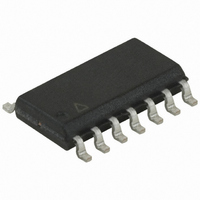ATTINY24-15SSZ Atmel, ATTINY24-15SSZ Datasheet - Page 51

ATTINY24-15SSZ
Manufacturer Part Number
ATTINY24-15SSZ
Description
MCU AVR 2K FLASH 15MHZ 14-SOIC
Manufacturer
Atmel
Series
AVR® ATtinyr
Datasheet
1.ATTINY24-15SSZ.pdf
(225 pages)
Specifications of ATTINY24-15SSZ
Package / Case
14-SOIC (3.9mm Width), 14-SOL
Voltage - Supply (vcc/vdd)
2.7 V ~ 5.5 V
Operating Temperature
-40°C ~ 125°C
Speed
16MHz
Number Of I /o
12
Eeprom Size
128 x 8
Core Processor
AVR
Program Memory Type
FLASH
Ram Size
128 x 8
Program Memory Size
2KB (2K x 8)
Data Converters
A/D 8x10b
Oscillator Type
Internal
Peripherals
Brown-out Detect/Reset, POR, PWM, WDT
Connectivity
USI
Core Size
8-Bit
Cpu Family
ATtiny
Device Core
AVR
Device Core Size
8b
Frequency (max)
16MHz
Interface Type
SPI/UART
Total Internal Ram Size
128Byte
# I/os (max)
12
Number Of Timers - General Purpose
2
Operating Supply Voltage (typ)
3.3/5V
Operating Supply Voltage (max)
5.5V
Operating Supply Voltage (min)
2.7V
On-chip Adc
8-chx10-bit
Instruction Set Architecture
RISC
Operating Temp Range
-40C to 125C
Operating Temperature Classification
Automotive
Mounting
Surface Mount
Pin Count
14
Package Type
SOIC
Lead Free Status / RoHS Status
Lead free / RoHS Compliant
Available stocks
Company
Part Number
Manufacturer
Quantity
Price
Company:
Part Number:
ATTINY24-15SSZ
Manufacturer:
ATMEL
Quantity:
349
Part Number:
ATTINY24-15SSZ
Manufacturer:
ATTINY
Quantity:
20 000
- Current page: 51 of 225
- Download datasheet (4Mb)
11. External Interrupts
11.1
7701D–AVR–09/10
Pin Change Interrupt Timing
The external interrupts are triggered by the INT0 pin or any of the PCINT11..0 pins. Observe
that, if enabled, the interrupts will trigger even if the INT0 or PCINT11..0 pins are configured as
outputs. This feature provides a way of generating a software interrupt. Pin change 0 inter-
rupts (PCI0) will trigger if any enabled PCINT7..0 pin toggles. Pin change 1 interrupts (PCI1)
will trigger if any enabled PCINT11..8 pin toggles. The PCMSK0 and PCMSK1 registers con-
trol which pins contribute to the pin change interrupts. Pin change interrupts on PCINT11..0
are detected asynchronously. This implies that these interrupts also can be used for waking
the part from sleep modes other than idle mode.
The INT0 interrupts can be triggered by a falling or rising edge or a low level. This is set up as
indicated in the specification for the MCU control register (MCUCR). When the INT0 interrupt
is enabled and is configured as level-triggered, the interrupt will trigger as long as the pin is
held low. Note that recognition of falling- or rising-edge interrupts on INT0 requires the pres-
ence of an I/O clock, described in
interrupt on INT0 is detected asynchronously. This implies that this interrupt also can be used
for waking the part from sleep modes other than idle mode. The I/O clock is halted in all sleep
modes except idle mode.
Note that if a level-triggered interrupt is used for wake-up from power-down, the required level
must be held long enough for the MCU to complete the wake-up to trigger the level interrupt. If
the level disappears before the end of the start-up time, the MCU will still wake up, but no
interrupt will be generated. The start-up time is defined by the SUT and CKSEL fuses as
described in
An example of timing of a pin change interrupt is shown in
Figure 11-1. Timing of pin change interrupts
pcint_setflag
pcint_in_(0)
PCINT(0)
pcint_syn
pin_sync
“System Clock and Clock Options” on page
pin_lat
PCINT(0)
PCIF
clk
clk
LE
pin_lat
Atmel ATtiny24/44/84 [Preliminary]
D
Q
pin_sync
“Clock Systems and their Distribution” on page
PCINT(0) in PCMSK(x)
pcint_in_(0)
0
x
clk
25.
Figure
pcint_syn
11-1.
pcint_setflag
PCIF
25. Low level
51
Related parts for ATTINY24-15SSZ
Image
Part Number
Description
Manufacturer
Datasheet
Request
R

Part Number:
Description:
Manufacturer:
Atmel Corporation
Datasheet:

Part Number:
Description:
Manufacturer:
Atmel Corporation
Datasheet:

Part Number:
Description:
IC MCU AVR 2K FLASH 20MHZ 20-QFN
Manufacturer:
Atmel
Datasheet:

Part Number:
Description:
IC MCU AVR 2K FLASH 20MHZ 14SOIC
Manufacturer:
Atmel
Datasheet:

Part Number:
Description:
MCU AVR 2K FLASH 15MHZ 20-QFN
Manufacturer:
Atmel
Datasheet:

Part Number:
Description:
IC MCU AVR 2K FLASH 20MHZ 14-DIP
Manufacturer:
Atmel
Datasheet:

Part Number:
Description:
MCU AVR 2KB FLASH 20MHZ 14SOIC
Manufacturer:
Atmel
Datasheet:

Part Number:
Description:
MCU AVR 2KB FLASH 20MHZ 20QFN
Manufacturer:
Atmel
Datasheet:

Part Number:
Description:
IC, MCU, 8BIT, 2K FLASH, 20SOIC
Manufacturer:
Atmel
Datasheet:

Part Number:
Description:
IC, MCU, 8BIT, 2K FLASH, 20PDIP
Manufacturer:
Atmel
Datasheet:

Part Number:
Description:
IC, MCU, 8BIT, 8K FLASH, 20PDIP
Manufacturer:
Atmel
Datasheet:

Part Number:
Description:
IC, MCU, 8BIT, 8K FLASH, 20SOIC
Manufacturer:
Atmel
Datasheet:











